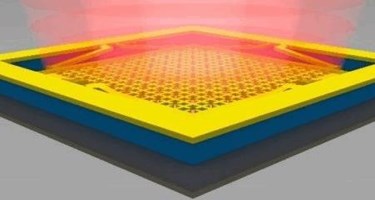Reconfigurable Metamaterial Device Harvests Energy From Excess Heat
By Jof Enriquez,
Follow me on Twitter @jofenriq

Researchers at Duke University have built a new reconfigurable device that can harvest energy from excess heat at infrared wavelengths. Such technology can be used to improve the efficiency of thermophotovoltaic cells, which collect waste heat from their surroundings in the form of infrared radiation and turn it into electricity.
Duke’s device is a metamaterial microelectromechanical system (MEMS), which consists of a metamaterial engineered to absorb and emit infrared wavelengths with very high efficiency, and a MEMS component made up of an 8 × 8 array of individually controllable pixels, each measuring 120 X 120 microns.
“In addition to allowing room-temperature operation, using metamaterials makes it simple to scale throughout the infrared wavelength range and into the visible or lower frequencies,” said Willie J. Padilla of Duke University in a news release. “This is because the device’s properties are achieved by the geometry, not by the chemical nature of the constituent materials that we're using.”
Scientists know that the geometry of a metamaterial can be configured to give off radiation within a specific spectral range, in contrast to standard materials that emit their heat in all directions as a broad range of infrared wavelengths. This makes metamaterial-based devices ideal for use as emitters paired with a thermophotovoltaic cells.
In the case of the Duke research team's infrared emitter device, they demonstrated that they could modify the patterns in the device’s movable top layer of patterned metallic metamaterial to create different-colored infrared pixels, each of which would be tunable in intensity. They report having achieved a range of infrared intensities equivalent to a temperature change of nearly 20 degrees Celsius, and display patterns at speeds of up to 110 kHz, or more than 100,000 times per second.
"Our results may be scaled to nearly any sub-optical range of the electromagnetic spectrum, and validate the potential of MEMS metamaterials to operate as reconfigurable multifunctional devices with unprecedented energy control capabilities," Padilla and study co-author Xinyu Liu wrote in the journal Optica.
In particular, such technology can be used to make more efficient thermophotovoltaics, a type of solar cell that converts infrared light (i.e., radiated heat from surroundings, instead of direct sunlight) into electricity, as conventional solar cells do. With new techniques being developed, solar thermophotovoltaic cells someday could be over 80 percent more efficient than conventional solar cells, according to MIT researchers who are working in the same area of interest.
